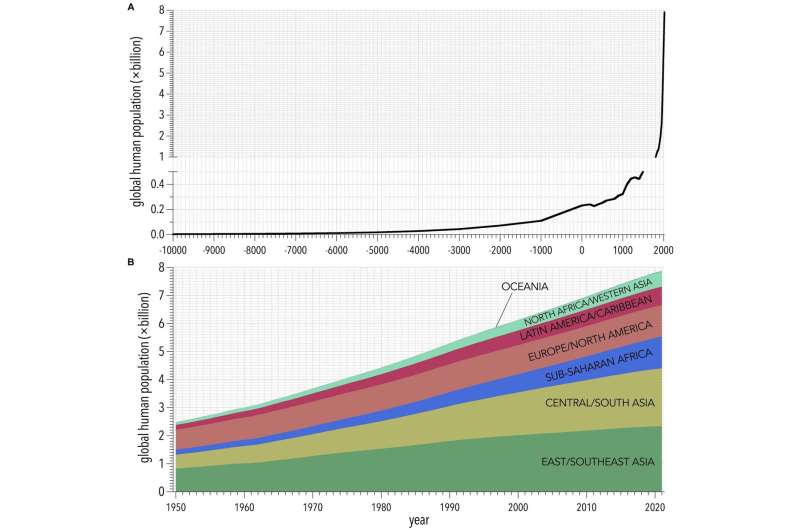This article has been reviewed according to Science X's editorial process and policies. Editors have highlighted the following attributes while ensuring the content's credibility:
fact-checked
trusted source
proofread
Improving women's fertility choices: Avoiding environmental catastrophe caused by population growth

Declining fertility rates and aging populations in Western nations have recently set off alarm bells, but continued global population growth will actually raise the pressure billions more people place on a destroyed environment, according to new research.
Scientists have assessed the risks that an expanding global population will have on global ecosystems and human societies in a new study published in the journal Frontiers in Public Health, which helps understand the direct relationship between population size and environmental decline.
These risks are global in scale and include increasing greenhouse-gas emissions, climate disruption, pollution, loss of biodiversity, and the spread of disease—all potentially catastrophic for our standard of living and well-being.
The study, led by Chitra Saraswati, a researcher with the Telethon Kids Institute, and Matthew Flinders Professor of Global Ecology Corey Bradshaw from Flinders University, shows that empowering women to make choices about their fertility and family planning is a core issue, but addressing it alone won't prevent overpopulation.
Professor Bradshaw said working to increase child health and introducing government policies that addressed food security and climate change would also help reduce unprecedented population growth.
"While a smaller human population will benefit the most people on Earth, we emphasize that we are not advocating an end to childbirth. Instead, we join the globally progressive voice of promoting the empowerment of girls and women worldwide through ethical and practical solutions to determine their own fertility," he said.
"Unfortunately, some national attitudes still obscure the links between population and environmental degradation, so traction for quality family planning in such regions has stalled."
"We also emphasize that determining family size should not be left to women alone; men also need to be educated adequately and provided with contraceptive options to allow them to promote prosperous and just outcomes for their family."
To quantify the scale of the problem, the experts scoured online databases to identify all relevant peer-reviewed and gray-literature sources examining the consequences of human population size and growth on the Earth's environment.
Their assessment shows that a global population of between nine and more than 10 billion by the end of this century is likely. The experts argue growing concerns about population decline ignore evidence of the economic and well-being advantages of smaller populations, as well as the fact that there is zero possibility of a "population collapse" over the coming century.
Co-author, Professor of Pediatrics Peter Le Souëf from The University of Western Australia emphasizes that children will suffer most from an increasing population.
"Most of the population increase will be in low-and middle-income nations where resources for children are already too limited to maintain their health. Rapidly expanding populations in impoverished nations will condemn children born there to increasing mortality rates and declining health that will soon reverse the hard-won advances made over recent decades," Professor Le Souëf said.
"To protect these children, stopping poverty is essential, but doing so will accelerate demand for natural resources and worsen climate change. Global strategies needed to prevent this from happening include reducing natural resource use, providing equity of access to these reduced resources, and improving fertility options for women."
Chitra Saraswati said a combination of factors linked to population growth would deplete natural resources and accelerate environmental degradation, so policies were needed to support countries going through demographic transition.
"We have to look at the big picture on unabated population growth to ensure progress occurs within planetary boundaries and promotes equity and human rights. Ensuring the well-being of all under this aim itself will lower population growth and promote environmental sustainability."
"Enabling a 'safe and just space for all' requires empowering women, improving health and well-being for women and their children, and increasing economic prosperity—actions that conveniently all lower fertility rates, knowing that falling fertility is indicative of economic development."
Co-author Dr. Melinda Judge from The University of Western Australia and the Telethon Kids Institute highlighted the need for increased global equity.
"Providing women and men the opportunity to determine their family size free of any form of coercion cannot be deemed 'population control'—rather, it is an important human right that has been neglected. In particular, empowering women—especially disadvantaged women—to make decisions about when and how many children they have will have positive impacts on their lives and the lives of their children, and is a proven path to overall development."
Alistair Currie, Head of Campaigns and Communications at Population Matters, said the dominance of the 'baby bust' narrative obscured the reality that the global population was set to grow by billions and that the consequences of that would be devastating for the most vulnerable communities.
"As this paper authoritatively shows, population growth holds people back from the lives they deserve and is one of the most important drivers of our environmental crisis. It's also the product of our shameful failure to achieve gender equality, tackle poverty, ensure that pregnancy, childbirth, and childhood are safe and healthy for everyone, and ensure people are able and free to use modern family planning so they can choose the family size they want."
More information: Chitra Maharani Saraswati et al, Net benefit of smaller human populations to environmental integrity and individual health and wellbeing, Frontiers in Public Health (2024). DOI: 10.3389/fpubh.2024.1339933




















